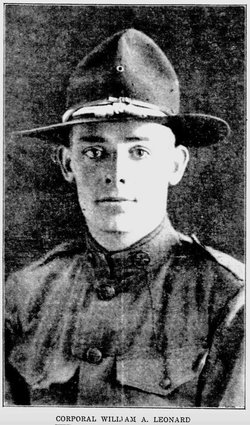Corporal William (Billy) Leonard (° 11 December 1889)
(3
was the son of John and Winifred Leonard from Flushing,
New York. During the war, he served with the 27th (New
York) Division. In civilian life he had been a journalist. His
friends knew him an sociable young man, who liked a laugh
and a joke. This was reflected in his newspaper articles,
where his unique approach to interesting stories was always
laced with humour. It was this same interested curiosity that
ultimately led to his death. Although he had no need to go
up to the front line, he volunteered for the task, saying that
he just wanted to see what it was like "up at the sharp end". 14 July 1918 - the
French national holiday - was a cold and wet day in Flanders. That night a British
guide led a party including Billy up to the Scherpenberg hill, beyond which lay
no-man's-land and Mount Kemmel. The area was full of Germans and danger was
ever present. Even so, Billy persuaded a number of British soldiers to take him out
on patrol to repair some barbed wire entanglements between the lines. The work
party left the safety of their trench around midnight and stumbled forward into the
dark. They had only just set out when the British opened up with a fierce artillery
bombardment of the German positions. Unsurprisingly, the Germans retaliated
in kind. The work party rushed back towards the trench but a shell exploded in
their midst. A British soldier was killed instantaneously and Billy was hit in the
stomach by a large piece of shrapnel. The other British troops picked up his limp
and bleeding body and dragged him back to their own lines, but when they arrived
they found that he was already dead. He was buried with the British soldier on the
southern slopes of the Scherpenberg hill, but his remains were later transferred o Lijssenthoek Military Cemetery (plot B - row 02 - grave 14). He was the first
to find new energy and courage. He was universally praised by his men for his
American battle casualty to die on Flemish soil.
Source: https://www.toerismeheuvelland.be/en/getfile/D230735261FRONTKAARTWO1DEFINITIEF_79247.pdf/bestand

PRIVATE CITIZENS SUPPORTING AMERICA'S HERITAGE
American
War Memorials Overseas, Inc.
War Memorials Overseas, Inc.
Leonard William 'Billy' Aloysius
Name:
William 'Billy' Aloysius Leonard
Rank:
Corporal
Serial Number:
Unit:
107th Infantry Regiment, 27th Division
Date of Death:
1918-07-14
State:
New York
Cemetery:
Flanders Field American Cemetery and Memorial Waregem, West Flanders, Belgium Add to Map
Plot:
B
Row:
2
Grave:
14
Decoration:
Comments:
